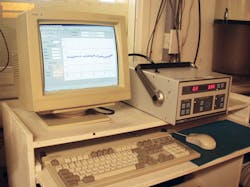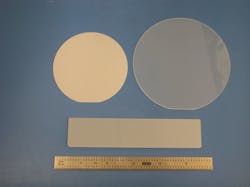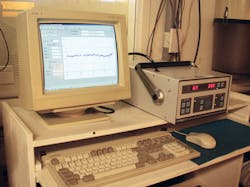This file type includes high resolution graphics and schematics when applicable.
Acoustic waves are part of the operating mechanisms of both surface-acoustic-wave (SAW) and bulk-acoustic-wave (BAW) components, although the two acoustic component types and technologies have essential differences. Both technologies can support a number of resonant-type components, including oscillators, filters, and delay lines. SAW components are limited in frequency compared to their BAW counterparts. However, both technologies provide effective circuits within their frequency ranges, and in small sizes that make them attractive for a wide number of applications in commercial, industrial, and military systems.
Both SAW and BAW components leverage the electromechanical properties of certain materials, notably anisotropic piezoelectric materials. Piezoelectric materials transform applied mechanical stress into electrical energy and can also convert electrical energy into mechanical stress.
SAW components make use of the electromechanical properties of these materials through the propagation of acoustic waves along the surface of the piezoelectric material. The acoustic waves travel through the interleaved metal “fingers” of interdigital transducers (IDTs) fabricated on the appropriate piezoelectric substrate.
Piezoelectric materials can produce electricity from applied mechanical stress, in addition to transforming applied electrical energy into mechanical energy, such as acoustic waves. This is accomplished by fabricating interdigital transducers (IDTs) on the surface of a piezoelectric substrate, such as lithium tantalite (LiTaO3, lithium niobate (LiNbO3), or quartz crystal.
Electrical RF/microwave energy at one end of the transducer is transformed into mechanical energy in the form of acoustic waves that travel along the interleaved metal fingers, and are transformed back to electrical RF/microwave energy at the other end of the transducer. With the slower velocity of these acoustic waves compared to the input RF/microwave waveforms, signal processing such as filtering and time delays can be performed in the acoustic frequency range, and then realized in the RF/microwave frequency range at the output of the SAW transducer.
Commercial SAW components can be fabricated on relatively large piezoelectric wafers (Fig. 1) compared to the smaller wafers used for fabricating semiconductor devices. Using larger wafers enables the production of relatively large volumes of SAW components for relatively low cost, with the opportunity to fabricate RF/microwave bandpass and other filters in much smaller sizes than ceramic filters for the same center frequency.
SAW components are typically manufactured at frequencies to about 2 GHz. Since the dimensions of the IDT structure shrink with increasing frequency, the challenges of producing SAW components with sufficiently small IDT dimensions to support those higher frequencies make it impractical at higher frequencies.
BAW components typically operate at higher frequencies that SAW components, almost starting where SAW components leave off—at about 1.5 GHz and higher. BAW components are also fabricated on piezoelectric materials, although typically using different substrate materials than their SAW counterparts.
In fact, one of the more popular piezoelectric substrate materials for BAW components is aluminum-nitride (AlN). BAW components also function differently than SAW components. In a BAW component, the acoustic waves travel and are stored in the piezoelectric material rather than across the top surface of the substrate.
Metallization for a BAW component is deposited on the top and bottom of the piezoelectric material, creating a form of acoustic channel for the waves. The acoustic waves essentially bounce between the metal layers and through the piezoelectric material, forming a standing acoustic wave. The resonant frequency of the standing wave is a function of the substrate thickness and the mass and type of metallization, with thinner substrates yielding higher operating frequencies.
Different types of metal films are used in BAW components than in SAW components—typically aluminum metallization for lower-power components and tungsten (W) for higher-power components. Although BAW components such as filters can be fabricated for use at frequencies below 1.5 GHz, and well into the frequency range of SAW components, the larger sizes of BAW components at those lower frequencies results in lower yields of components per piezoelectric wafer, making it difficult to be cost-competitive with SAW filters or even ceramic filters at those lower frequencies.
BAW components operate to higher frequencies than SAW components—about 15 GHz and higher compared to SAW components, which are available to about 2 GHz. The nature of BAW components, with high-density acoustic energy stored within the metal plates of a piezoelectric substrate, results in lower-loss components at higher frequencies than SAW components.
They are also capable of high-quality-factor (high-Q) resonators in relatively small sizes for microwave filters with high rejection and sharp band edges. In general, BAW components (such as filters) can typically achieve lower passband insertion loss than SAW filters, although usually at higher frequencies.
At frequencies of about 2 GHz or below, SAW filters are capable of excellent rejection of unwanted, out-of-band signals while maintaining flat amplitude response across the passband frequency range. In general, SAW components exhibit greater variations in performance with temperature than BAW components at their higher frequencies, although careful selection of SAW substrate materials can help limit these performance variations. In addition, some manufacturers offer temperature-compensated SAW (TC-SAW) components to minimize temperature variations without sacrificing the excellent electrical performance of SAW technology.
Similarly, some suppliers offer BAW components, mainly filters, based on “low-drift” piezoelectric materials that minimize variations in frequency with temperature, usually characterized in parts per million per degrees Centigrade (ppm/°C). The temperature shifts for these components can be in terms of negative or positive values (changes in frequency with temperature), with an ideal component characterized by 0 ppm/°C. At least one manufacturer offers these low-drift BAW components at frequencies to 9 GHz and higher.
By applying consistent manufacturing practices, quality control, and computer-controlled test methods (Fig. 2), some manufacturers of SAW components—such as Phonon Corp.—have succeeded in achieving some of the highest quality levels in SAW components like filters, delay lines, oscillators, and modules. These quality levels are sufficient for an exclusively military customer base.
This file type includes high resolution graphics and schematics when applicable.
About the Author
Jack Browne
Technical Contributor
Jack Browne, Technical Contributor, has worked in technical publishing for over 30 years. He managed the content and production of three technical journals while at the American Institute of Physics, including Medical Physics and the Journal of Vacuum Science & Technology. He has been a Publisher and Editor for Penton Media, started the firm’s Wireless Symposium & Exhibition trade show in 1993, and currently serves as Technical Contributor for that company's Microwaves & RF magazine. Browne, who holds a BS in Mathematics from City College of New York and BA degrees in English and Philosophy from Fordham University, is a member of the IEEE.




